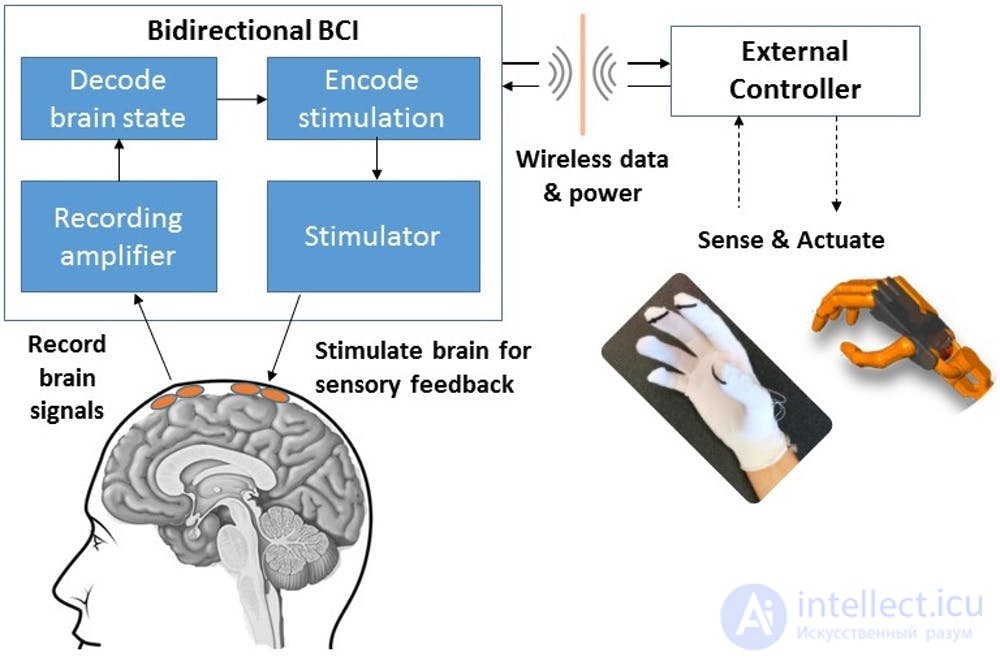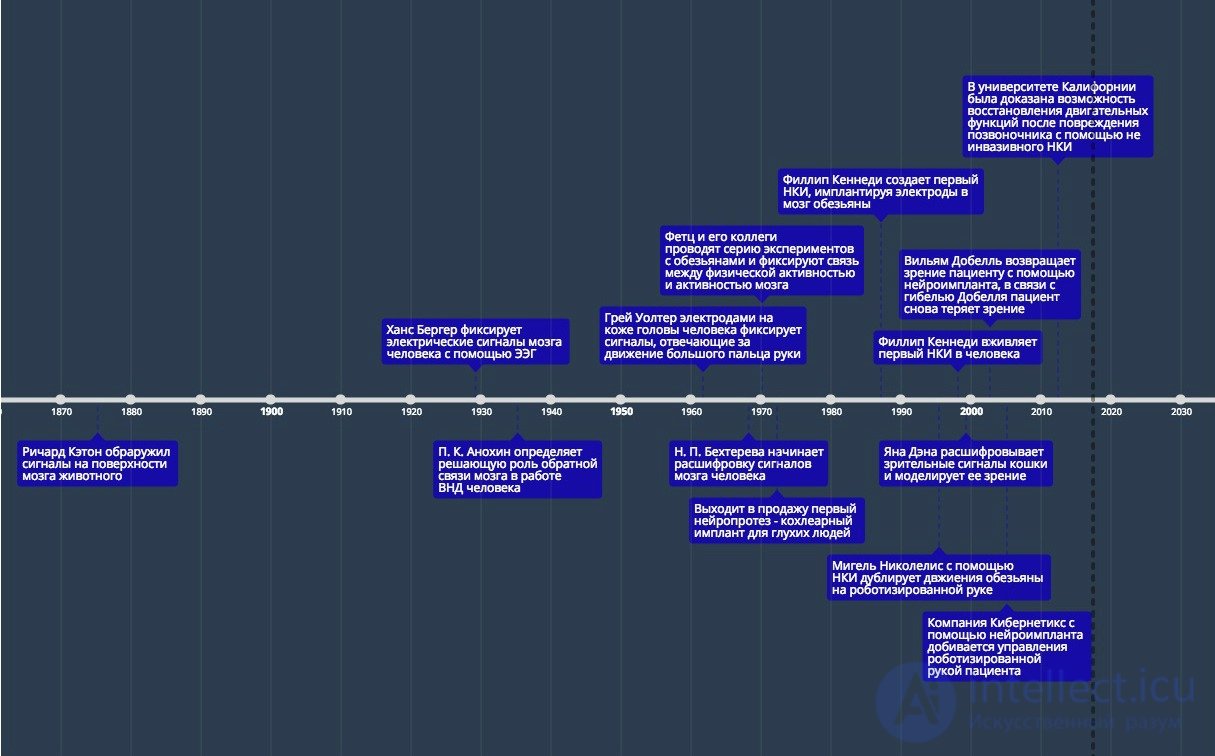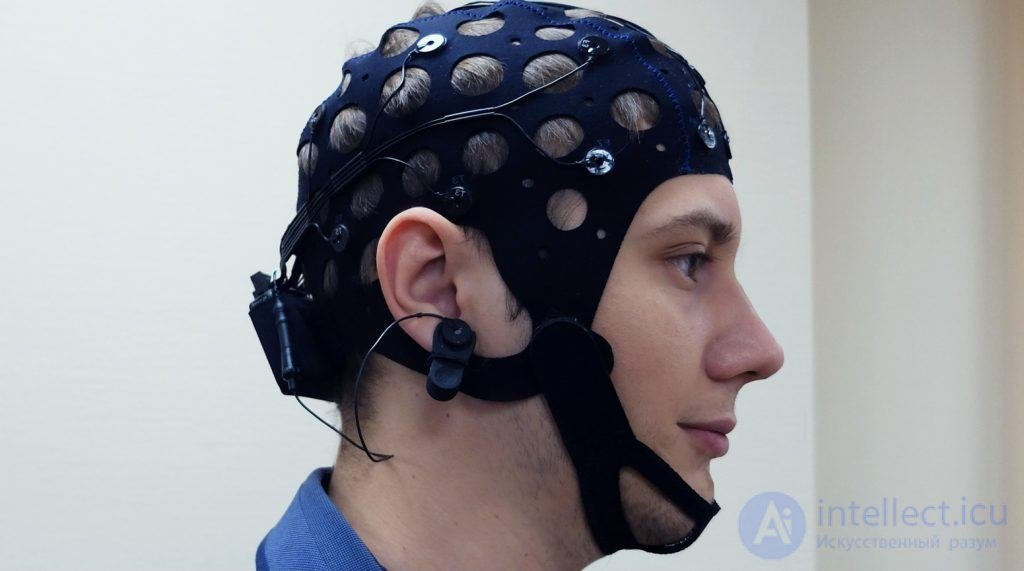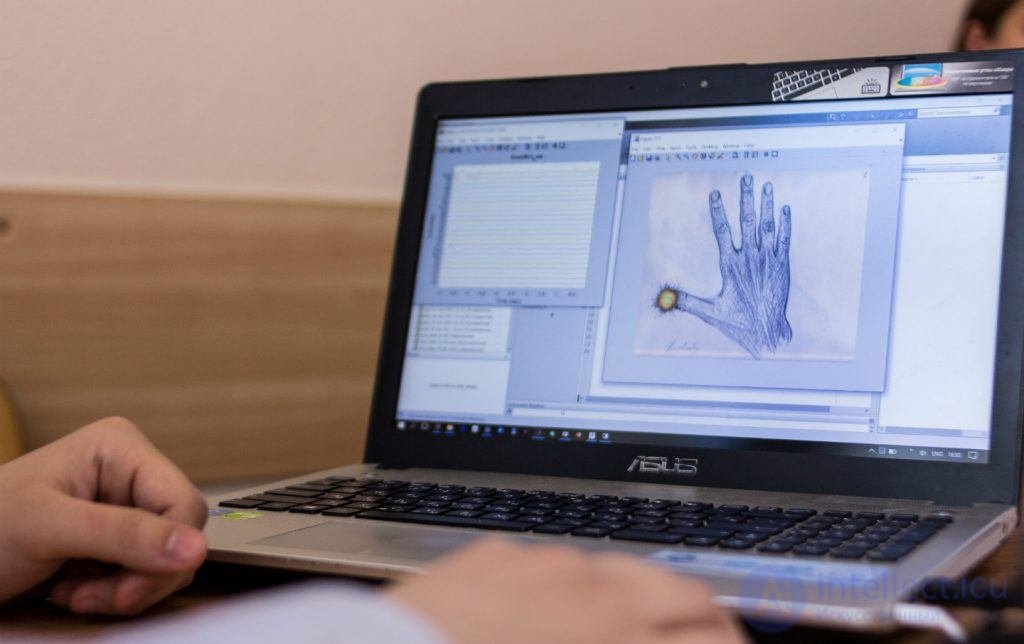Lecture
A neurocomputer interface (NCI) (also called a direct neural interface , a brain interface , a brain-computer interface ) is a system designed to exchange information between the brain and an electronic device (for example, a computer). In unidirectional interfaces, external devices can either receive signals from the brain, or send signals to it (for example, simulating the retina of an eye when restoring vision with an electronic implant). Bidirectional interfaces allow the brain and external devices to exchange information in both directions. At the core of the neuro-computer interface, the biofeedback method is often used.
 Center for Sensorimotor Neural Engineering (CSNE), CC BY-ND A two-way brain-computer interface (BBCI) can read signals from the brain and send information back to the brain via stimulation.
Center for Sensorimotor Neural Engineering (CSNE), CC BY-ND A two-way brain-computer interface (BBCI) can read signals from the brain and send information back to the brain via stimulation.
It is easier to understand what a neural interface is when you come across its other name: the brain-computer interface or the neuro-computer interface (NCI). It is a connection between the brain and a computer, created for one-way or two-way communication using electrical signals.
If you choose the three most influential researchers in the history of the development of neural interfaces, it will be Philip Kennedy, William Dobell and the company Cybernetics.

Neurologist Philip Kennedy (Philip Kennedy) first introduced NCI in the monkey brain in 1987, and in 1998 - in the human brain. After the ban to experiment on humans, Kennedy implanted electrodes into his own brain, and then removed them after several days of successful tests.
The doctor and researcher William Dobell (William Dobell) in 2002 partially restored the sight to the patient with the help of a neuroimplant. The NEC Dobella system included a black-and-white camera, a range finder and a five-kilogram computer connected to the electrodes in the cortex. This was enough for the patient to drive the car in the parking lot. After Dobella died in 2004, the patient lost his sight again.
In 2005, Cybernetics (Cybernetics, USA) achieved impressive results in the implantation of NCI into the human brain, which allowed the patient to control a robotic arm.
NPIs are of three types, each of which is determined by the method of signal transmission.
Invasive interfaces imply the implantation of electrodes in the brain and provide a direct neural connection. Despite the high efficiency and purity of the signal, this species has a serious drawback - over time, neurons lose sensitivity, and for continued use you have to install them again in a different place.
In semi-invasive neural interfaces, electrodes are attached to the surface of gray matter.
In non-invasive - electrodes are mounted on the head by the method of electroencephalogram (EEG). Due to this, there are no limitations associated with loss of sensitivity, however, there are other disadvantages: installation time, offset as used, the need to update the conductive gel and the inability to attach the electrode to the desired group of neurons. Because of these features, non-invasive NCI systems need to be trained to identify the signals of each specific user.
What is NKI used for?
The science. The discovery of brain signals and their connection with human activity at one time gained scientific weight comparable to DNA research and the interpretation of the human genome. Until now, the scientific community knows the work of the brain through its electrical conductivity, and new discoveries take place every year.
Prosthetics Neuroprostheses are considered a standard method for solving the problem of hearing loss, used to treat certain diseases. On the approach control exoskeletons and robotic prosthetic arms and legs.
The medicine. Recovery from injuries of the brain, spine, strokes, paralysis - all these are areas where NCI is successfully applied.
Entertainment and gaming industry. Since 2012, the NKI boom in the gaming industry has taken place: from “rope pulling”, or rather, a ball in a MindBall device, to controlling a ball in a tube in Star Wars Force Trainer. Unfortunately, many devices in this category use the name of the neural interface, having nothing to do with it. Some read the tension of the facial nerves, others measure the tension on the head itself, not reaching the neurons. In general, most devices in these areas use the intriguing prefix "Neuro", but in reality do not use brain signals.
What is happening in the market: giants and independent startups
The market for neural interfaces is similar in its own way to other innovative areas: giants like Facebook and Ilona Mask are already involved in the work, major manufacturers are gaining weight, and young startups are delivering fresh ideas. Let's look at the most interesting players.
Neuralink is the company that Ilon Musk bought and headed. The exact details of the purpose and scope of the implementation of the object of development are still unknown, but Musk has already said that the device will be produced in the next four years. It is assumed that this will be a two-way communication with the brain. Musk also said that it is not necessary to implant the interface into the brain, you can put it into the body through an injection into the neck, and then it will get to the brain independently.
Neurable is a very interesting company that develops NCI for managing gadgets and software, including computer interfaces, helmets and virtual reality glasses. Combining three-dimensional images in a helmet or glasses with control of the power of thought, the company has achieved unique gaming sensations.
Muse determines the state of the brain during meditation and, based on it, creates the musical accompaniment for a deeper and more conscious immersion. The ergonomic design of the device and the provision of access to the original recorded data allowed novice developers to get acquainted with the world of brain signals and implement their first applications.
G.tec's intendiX device performs three functions:
- after a short training period of 10 minutes, NCI allows typing with a thought that helps people with speech disorders after injuries or illnesses to interact with other people;
- cursor control when working with a PC, including in computer games. The successful implementation touched even the famous World of Warcraft game of the Blizzard project: you can control the character without using your hands to within 98%;
- drawing with thought at a speed of 5-10 actions per minute.
In Russia, development is carried out at research institutes and universities, as well as in commercial companies. Separately, it is worth mentioning the company NeuroG, iBrain, United Instrument Engineering Corporation (included in Rostec) and Cyber Myonics.
We interviewed Konstantin Sonkin, CEO of iBrain. The company is developing a neural interface used to rehabilitate patients who have suffered a stroke or brain injury. One of the successfully completed tasks of the company is a device of miniature size, allowing it to be used at home or in rehabilitation centers and boarding houses.
According to Konstantin, the idea of creating a neural interface appeared seven years ago in the process of writing a Ph.D. thesis under the guidance of Professor Lev Stankevich, an expert in artificial intelligence. A true forecast of the development of the industry made it possible to foresee an annual market growth rate of almost 40% (by 2020, the market for neural interfaces may reach $ 350 billion). After the completion of fundamental research, which lasted 7 years, iBrain company was established, which included specialists from different fields of science.
“We created a brain-computer interface based on motor imagination, that is, we implemented an approach that uses only the imagination of motion without its physical execution. Thus, based on the data from the electroencephalogram, we can track the patient's imaginary movement and give feedback on it, ”says the company's CEO.
The NCI, developed by iBrain, is required for a wide range of patients, and in the first place, it is patients who have suffered a stroke, brain or spinal injury. In many cases, there is reason to believe that this approach will help slow the development of diseases such as Alzheimer's disease and ALS (amyotrophic lateral sclerosis that Stephen Hawking is ill with).
Konstantin gives frightening statistics: in Russia alone, more than half a million people suffer from a stroke every year, and in the world over the same period 5,000,000 people become disabled. The age of those who fall victim to a stroke is constantly decreasing: now we meet a stroke in 25-year-olds. In patients, parts of the brain are damaged and some structures die, which often leads to impairment of motor functions: immobilization of limbs, impaired fine motor skills and even paralysis of half of the body.
Modern solutions are based on physiotherapy - massage, physical flexion and extension of the limbs. “Such solutions are needed, and we do not force out, but complement these techniques, because they themselves do not restore the brain structures in which the disturbances occurred. Our system of recognition of imaginary movements and the provision of feedback on it is aimed at exactly that, ”explains Konstantin.

The iBrain research confirms the scientific assumptions that during a systematic work, the brain structures are consolidated and new structures are being formed instead of those lost during injury.
“In order to increase the motivation of patients towards using the neurorehabilitation system, we are developing unique rehabilitation games of a kind, where management is carried out by means of imagination of movements that need to be restored,” says Konstantin.
“The urgency is reinforced by the fact that due to the inability to control the limbs during the year, the remaining brain structures responsible for movement begin to degrade. It is necessary to start neurorehabilitation as early as possible, which, in case of timely use, can speed up the recovery process by a factor of 2-3. If it is impossible to restore motor function, for example, in case of a fracture of the spine, this technology is used to manage a wheelchair or exoskeleton, ”says the project manager.
In their work, iBrain uses EEG amplifiers of the Russian company MITSAR, which has developed a unique modification of the mobile wireless encephalograph for the project. All calculations are performed by a regular laptop or tablet.

“Rehabilitation can take place in a hospital or sanatorium, but the need to come to receptions or keep a place for the patient can lead to severe restrictions, and most importantly, time will be lost. Therefore, one of our tasks is to create an opportunity to come to the patient's home and carry out rehabilitation in the place where he is. Our device allows you to do this at the expense of compactness and ease of use. "
The project faces standard difficulties, bureaucratic and financial.
“This is a vicious circle - without investment, you cannot enter production, without production you cannot come to investment. We could be developing much faster, but we have to find a balance between finding resources and moving forward. Despite this, we are not ready to start up any investor in the project, it is important for us to preserve the scientific validity of the development, and not to join the race to achieve financial performance at any price, ”says Konstantin.
Pilot test is scheduled for autumn 2017. We are sure that we will hear more than once about the successes of iBrain, which we are grateful for the opportunity to talk about such developments today.
Despite the incredible success of individual neural interfaces, we are at the very beginning of their use. Nowadays, the expectations from NCI have grown many times, as well as the technical capabilities of the devices that form the foundation of the development. But in the coming years we should not expect a revolution in the use of neural interfaces to solve everyday problems.
There is a gradual evolution of neuroprostheses, rehabilitation systems and rehabilitation of patients with brain damage and motor functions. And in the next five years, the appearance of robotic prostheses, controlled by brain commands, is expected, but controlling the mouse cursor with thought is still a difficult task.
Comments
To leave a comment
Computational Neuroscience (Theory of Neuroscience) Theory and Applications of Artificial Neural Networks
Terms: Computational Neuroscience (Theory of Neuroscience) Theory and Applications of Artificial Neural Networks